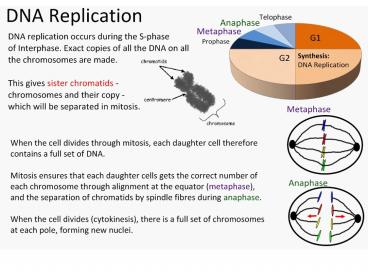Your task PowerPoint PPT Presentation
1 / 23
Title: Your task
1
(No Transcript)
2
(No Transcript)
3
(No Transcript)
4
(No Transcript)
5
(No Transcript)
6
(No Transcript)
7
(No Transcript)
8
(No Transcript)
9
(No Transcript)
10
(No Transcript)
11
(No Transcript)
12
(No Transcript)
13
(No Transcript)
14
(No Transcript)
15
(No Transcript)
16
(No Transcript)
17
(No Transcript)
18
(No Transcript)
19
(No Transcript)
20
Your task To use a vine to explain the role of
the enzymes in DNA Replication You must create
two Vines One for the lagging strand
- One for the leading strand Your Vines must
include the following Tag for Vines -
profbio DNA Helicase RNA Primase DNA
Polymerase III DNA Polymerase I DNA Ligase All
enzymes must be labeled and the process must
result in the formation of two strands of DNA
produced semi-conservatively.
21
So, how can scientists use this information about
how DNA replication works?
POLYMERASE CHAIN REACTION
GENE TRANSFER
From http//site.motifolio.com/images/Gene-transf
er-mechanisms-1021148.png
From https//antisensescienceblog.wordpress.com/2
013/12/04/a-cornerstone-of-molecular-biology-the-p
cr-reaction/
22
Polymerase Chain Reaction
- Used to amplify small samples of DNA
- In order to use them for DNA profiling,
recombination, species identification or other
research. - The process needs a thermal cycler, primers, free
DNA nucleotides and DNA polymerase. - Heating in the thermal cycler denatures hydrogen
bonds, exposing bases. - The mixture cools. Primers are added to the start
of the target genes. - DNA Polymerase replicates the DNA using
complementary base pairing. - This cycle is repeated many times, until there
are thousands of copies enough to amplify even
tiny samples found at a crime scene!
Animation from McGraw Hill http//highered.mcgraw
-hill.com/olc/dl/120078/micro15.swf
You do not need to know details of this method,
but can you see how the technology has mimicked
the natural process of DNA replication?
Animation from DNAi.org http//www.dnai.org/tex
t/mediashowcase/index2.html?id582
23
Genetic Engineering
Also known as genetic modification, gene transfer
or transgenics.
- All living things use the same bases and the same
genetic code. - Each codon produces the same amino acid in
transcription and translation, regardless of the
species. - So the sequence of amino acids in a polypeptide
remains unchanged. - Therefore, we can take genes from one species and
insert them into the genome of another species.
The Genetic Code is Universal
restriction
We already make use of gene transfer in
industrial production of insulin http//www.abpis
chools.org.uk/res/coResourceImport/modules/hormone
s/en-flash/geneticeng.cfm

